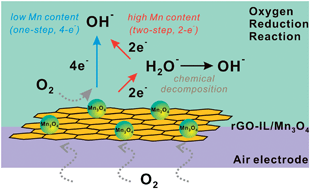Ionic liquid modified graphenenanosheets anchoring manganese oxide nanoparticles as efficient electrocatalysts for Zn–air batteries†
Abstract

* Corresponding authors
a
Interdisciplinary School of Green Energy and School of NanoBioscience and Chemical Engineering, Ulsan National Institute of Science and Technology (UNIST), Ulsan, Korea
E-mail:
jpcho@unist.ac.kr, bskim19@unist.ac.kr
Fax: +82-52-217-2019
Tel: +82-52-217-2923

 Please wait while we load your content...
Something went wrong. Try again?
Please wait while we load your content...
Something went wrong. Try again?
J. Lee, T. Lee, H. Song, J. Cho and B. Kim, Energy Environ. Sci., 2011, 4, 4148 DOI: 10.1039/C1EE01942B
To request permission to reproduce material from this article, please go to the Copyright Clearance Center request page.
If you are an author contributing to an RSC publication, you do not need to request permission provided correct acknowledgement is given.
If you are the author of this article, you do not need to request permission to reproduce figures and diagrams provided correct acknowledgement is given. If you want to reproduce the whole article in a third-party publication (excluding your thesis/dissertation for which permission is not required) please go to the Copyright Clearance Center request page.
Read more about how to correctly acknowledge RSC content.
 Fetching data from CrossRef.
Fetching data from CrossRef.
This may take some time to load.
Loading related content
